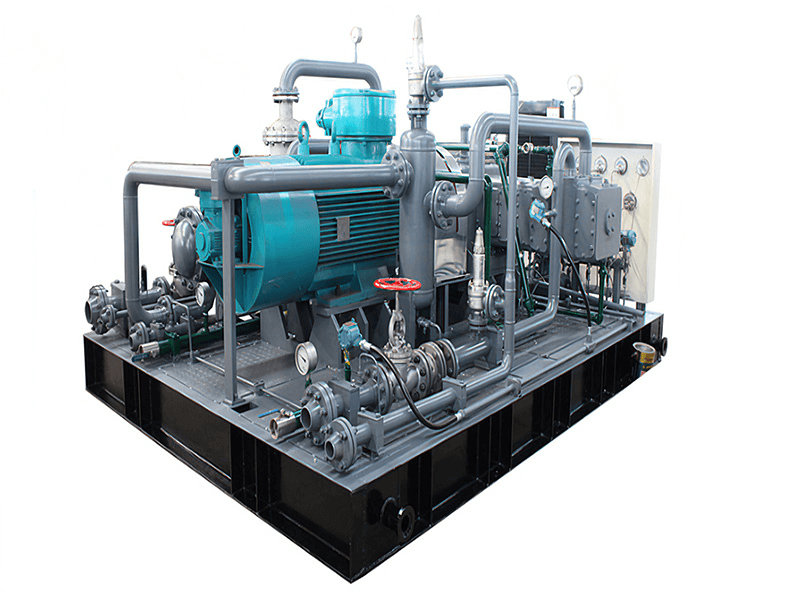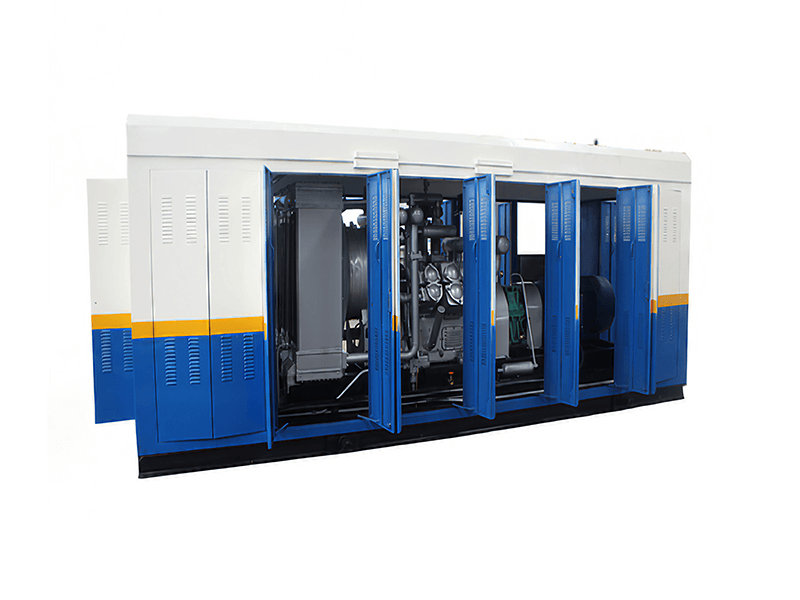A CNG (Compressed Natural Gas) standard station compressor is a critical component of a CNG fueling station. It is responsible for compressing natural gas from the utility pipeline or storage tanks to the high pressures required for vehicle refueling. The compressor plays a key role in ensuring the efficient and reliable operation of the station. CNG standard station compressors typically employ multi-stage compression. This means that the compression process occurs in several stages, with each stage progressively increasing the gas pressure.
Working principle of CNG Standard Station Compressor
The working principle of a CNG standard station compressor involves the compression of natural gas from a lower pressure to a higher pressure suitable for vehicle refueling. The compressor follows a series of steps to achieve this process. Here's a general overview of the working principle:
1. Inlet Stage:
- The natural gas enters the compressor through an inlet valve or port. It may be sourced from the utility pipeline or storage tanks.
- The gas flows into the compression chamber, which is typically a cylinder or a chamber created by the compressor's rotors or pistons.
2. Compression Stage:
- The compression stage is where the actual compression of the gas takes place.
- In reciprocating compressors, pistons move back and forth within the cylinders. During the forward stroke, the piston compresses the gas by reducing the volume of the compression chamber. This increases the pressure of the gas.
- In rotary screw compressors, the interlocking rotors create compression chambers. As the rotors rotate, the gas is trapped in the chambers and compressed as the chambers become smaller, increasing the pressure.
3. Pressure Build-up:
- As the compression stage continues, the gas pressure gradually increases.
- For multi-stage compressors, the gas may pass through multiple compression stages, each further increasing the pressure.
- The compressor's design and configuration determine the number of stages and the pressure increase achieved in each stage. This ensures that the gas reaches the required high pressure for CNG vehicle refueling.
4. Cooling and Lubrication:
- During the compression process, the gas temperature increases due to adiabatic compression.
- Cooling systems, which can use air or water, are employed to maintain acceptable operating temperatures. Cooling helps prevent overheating of the compressor and ensures efficient operation.
- Compressors also require lubrication systems to reduce friction and wear between moving parts. Lubricants help maintain smooth operation and extend the compressor's lifespan.
5. Outlet Stage:
- Once the gas reaches the desired pressure, it exits the compressor through an outlet valve or port.
- The compressed gas is then directed to storage vessels or distribution systems within the CNG standard station, where it is stored or dispensed for vehicle refueling.
Throughout the entire process, control and monitoring systems ensure the safe and efficient operation of the compressor. These systems regulate the compressor's startup, shutdown, and operational modes, while also monitoring parameters such as pressure, temperature, and vibration levels.
It's important to note that the specific working details of a CNG standard station compressor may vary depending on the type of compressor (reciprocating, rotary screw, centrifugal, diaphragm) and its design. However, the fundamental principle remains consistent: compressing natural gas to the required pressure for CNG vehicle refueling.
Types of CNG Standard Station Compressor
There are two common types of compressors used in CNG (Compressed Natural Gas) standard stations: reciprocating compressors and rotary screw compressors. Each type has its own characteristics and advantages. Let's explore them in more detail:
1. Reciprocating Compressors:
- Reciprocating compressors use pistons and cylinders to compress the natural gas. They operate on the principle of positive displacement, where the gas is trapped in the compression chamber and compressed by the reciprocating motion of the piston.
- Advantages:
- High Efficiency: Reciprocating compressors are known for their high efficiency, making them suitable for CNG standard stations that require efficient compression of natural gas.
- Wide Pressure Range: They can handle a wide range of pressure requirements, from lower pressures up to very high pressures required for CNG vehicle refueling.
- Reliable Operation: Reciprocating compressors are known for their reliability and long service life.
- Modular Design: They can be designed with multiple cylinders, allowing flexibility in adjusting the compression capacity according to the station's needs.
- Disadvantages:
- Higher Maintenance: Reciprocating compressors require regular maintenance, including lubrication and periodic inspections of valves and seals.
- Vibration and Noise: These compressors generate more vibration and noise compared to rotary screw compressors.
2. Rotary Screw Compressors:
- Rotary screw compressors use two interlocking rotors to compress the natural gas. The rotors, typically helical in shape, rotate in opposite directions, trapping and compressing the gas between them.
- Advantages:
- Lower Vibration and Noise: Rotary screw compressors operate more quietly and have lower vibration levels compared to reciprocating compressors.
- Continuous Operation: They provide continuous compression, making them suitable for high-flow rate applications.
- Compact Design: Rotary screw compressors are often more compact and require less space compared to reciprocating compressors.
- Lower Maintenance: They generally require less maintenance compared to reciprocating compressors, reducing downtime and associated costs.
- Disadvantages:
- Limited Pressure Range: Rotary screw compressors are better suited for lower to medium pressure ranges and may not be suitable for extremely high-pressure applications.
- Lower Efficiency at High Pressures: Their efficiency can decrease at higher pressures compared to reciprocating compressors.
Certainly! Here are a few more types of compressors used in CNG standard stations:
3. Centrifugal Compressors:
- Centrifugal compressors use rotating impellers to compress the natural gas. The impellers accelerate the gas, creating a centrifugal force that compresses it.
- Advantages:
- High Flow Rates: Centrifugal compressors are capable of handling large flow rates, making them suitable for high-demand CNG stations.
- Compact Design: They have a compact footprint and require less space compared to reciprocating or rotary screw compressors.
- Lower Maintenance: Centrifugal compressors generally require less maintenance and have longer service intervals.
- Disadvantages:
- Limited Pressure Ratios: Centrifugal compressors are typically used for lower pressure ratios and may not be suitable for very high-pressure applications.
- Higher Power Consumption: They can consume more power compared to other compressor types.
4. Diaphragm Compressors:
- Diaphragm compressors use a flexible diaphragm to compress the natural gas. The diaphragm moves back and forth, creating compression chambers that compress the gas.
- Advantages:
- Leak-Free Compression: Diaphragm compressors provide leak-free compression, making them suitable for applications where gas contamination or leakage is a concern.
- High Purity Compression: They are often used for compressing gases that require high purity levels, as the diaphragm isolates the gas from the compressor lubrication system.
- Disadvantages:
- Lower Flow Rates: Diaphragm compressors are typically used for lower flow rate applications and may not be suitable for high-demand CNG stations.
- Limited Pressure Range: They are better suited for lower to medium pressure ranges and may not be suitable for very high-pressure applications.
The selection of a compressor type for a CNG standard station depends on factors such as the station's capacity requirements, pressure specifications, available space, and operational considerations. Stations may employ a combination of different compressor types based on their specific needs.
It's important to consult with industry experts and equipment manufacturers to determine the most suitable compressor type and configuration for a CNG standard station, considering factors such as efficiency, reliability, maintenance requirements, and long-term cost considerations.
Price ranges of CNG Standard Station Compressor
The price range of a CNG (Compressed Natural Gas) standard station compressor can vary significantly depending on several factors such as the compressor type, capacity, brand, quality, additional features, and market conditions. It's important to note that the prices provided here are approximate and can fluctuate based on various factors. Here's a general overview of the price ranges:
1. Reciprocating Compressors:
- Smaller Capacity (up to 1000 SCFM): $20,000 - $50,000
- Medium Capacity (1000-3000 SCFM): $50,000 - $150,000
- Larger Capacity (3000+ SCFM): $150,000 - $500,000+
2. Rotary Screw Compressors:
- Smaller Capacity (up to 1000 SCFM): $15,000 - $40,000
- Medium Capacity (1000-3000 SCFM): $40,000 - $100,000
- Larger Capacity (3000+ SCFM): $100,000 - $400,000+
3. Centrifugal Compressors:
- Medium to Large Capacity: $200,000 - $1,000,000+
4. Diaphragm Compressors:
- Smaller to Medium Capacity: $30,000 - $100,000
These price ranges are rough estimates and can vary based on several factors, including the specific capacity requirements, quality of components, additional features (such as cooling systems, control systems), installation requirements, and local market conditions. Prices can also differ based on the region or country where the compressor is purchased.
It's essential to consider not only the initial purchase cost but also long-term factors such as maintenance requirements, energy efficiency, and reliability when evaluating the overall value of a CNG standard station compressor.
To obtain accurate and up-to-date pricing information, it's recommended to consult with reputable compressor manufacturers, suppliers, or industry experts who can provide detailed quotes based on your specific requirements.


























